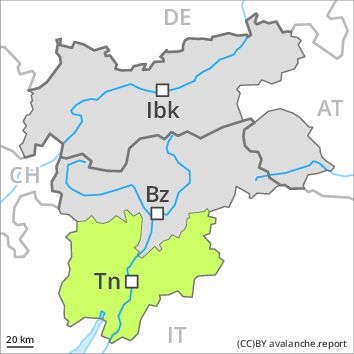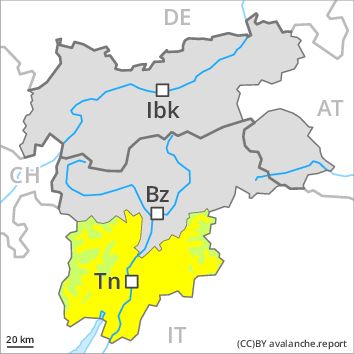Regions
Latemar, Southern Adamello, Primiero - Pale di S. Martino, Adamello - Presanella, Prealps, Northern Brenta - Peller, Cembra Valley, Bondone and Stivo, Vallarsa, Western Nonsberg Alps, Folgaria - Laverone, Southern Brenta, Fassa Valley, Sole, Pejo and Rabbi, Southern Lagorai, Ledro Valley, Northern Lagorai, Maddalene, Paganella, Marzola - Valsugana, Pine' - Mocheni Valley
AM
Danger level
PM
Danger level
Avalanche Problem
Gliding snow above 2600m, E-SE-S-SW-W
Wet snow above 2600m, E-SE-S-SW-W
Gradual increase in avalanche danger as a consequence of warming during the day and solar radiation.
The Avalanche Warning Service currently has only a small amount of information that has been collected in the field. The avalanche conditions in the morning are favourable.
Midday and afternoon: Gradual increase in avalanche danger as a consequence of warming during the day and solar radiation. Gliding avalanches and wet snow slides are the main danger. The avalanche prone locations are to be found in particular on very steep sunny slopes below approximately 2600 m. These places are rather rare and are easy to recognise. Apart from the danger of being buried, restraint should be exercised as well in view of the danger of avalanches sweeping people along and giving rise to falls.
Precautionary closures of exposed transportation routes may be necessary in some localities.
In addition a low (level 1) danger of dry slab avalanches exists. This applies in particular on extremely steep shady slopes above approximately 2400 m. The avalanches are rather small and can be released by large loads.
Snowpack
dp 2: gliding snow
dp 10: springtime scenario
Outgoing longwave radiation during the night will be quite good. The snowpack will become moist as the day progresses. This applies in particular on sunny slopes.
The somewhat older wind slabs are lying on weak layers in particular on shady slopes at high altitude. Such avalanche prone locations are rare.
The old snowpack will be in most cases stable. At intermediate altitudes hardly any snow is lying. At low altitude no snow is lying.
Tendency
Gradual increase in danger of dry and moist avalanches as a consequence of warming during the day and solar radiation.